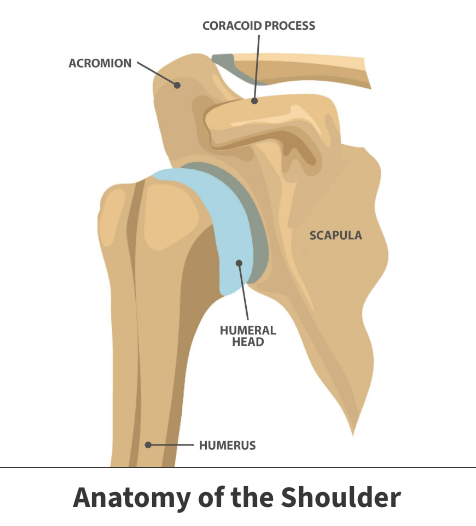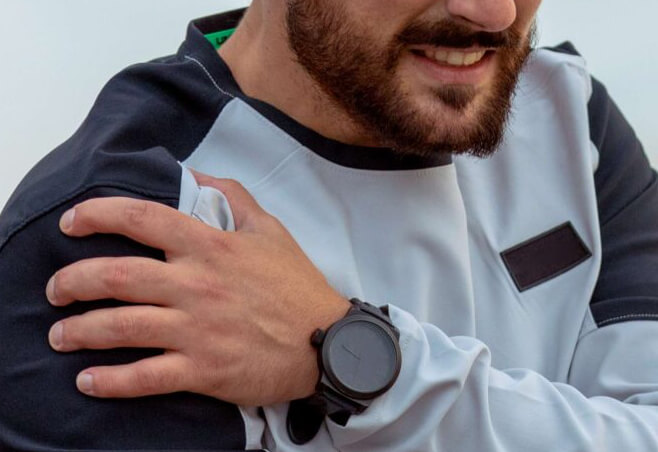Slap tears & repairs
Healthy shoulders play a vital role in your ability to properly move your arms and carry out essential movements like lifting objects. Shoulder injuries can prove detrimental to your mobility and overall well-being. One specific type of shoulder injury is a SLAP tear, which is short for damage to the Superior Labrum Anterior and Posterior.
Anatomy

The shoulder is a complex ball and socket joint connected to three bones: the shoulder blade (the scapula), the upper arm bone (the humerus), and the collarbone (the clavicle).
The top of your upper arm bone connects to a socket called the glenoid. The labrum is a collection of fibrous tissue surrounding the glenoid. The labrum performs several vital functions and is a major part of your shoulder. It helps the shoulder joint maintain proper stability. Many soft tissues such as ligaments and tendons are attached to the labrum.
About
When a SLAP injury occurs, the superior or top part of the labrum sustains damage. Damage typically occurs as tearing or ripping.
Causes
SLAP injuries can occur from traumatic events such as:
- Car accidents
- Major falls
- Extreme, immediate pressure is placed upon the shoulder from lifting or carrying an excessively large or heavy object
Such damage can also result from repetitive, sharp, or unusual movement of the shoulder joint over long periods. Your chances of being affected by these circumstances increase if you frequently take part in any sports or are employed in a career that requires repeated lifting.
SLAP tears can also result from the wearing down of the labrum that occurs slowly over time. Tearing or fraying of the superior labrum is part of the normal process of aging in people over 30 to 40 years of age, and is different from an acute injury in a younger person.

Symptoms
The symptoms you experience often depend on the SLAP tear’s severity. The following occurrences are not uncommon:
- Pain, particularly when lifting objects
- The feeling that the shoulder is unstable and might pop out of place
- Shoulder weakness
- Increased discomfort when holding your shoulder in various positions
- Reduced shoulder mobility
- In moderate to severe cases, you might feel what is described as a dead arm. This is a complete numbness or a dead feeling.
Diagnosis
The symptoms of SLAP tears are often seen in other shoulder injuries. Your doctor will need to perform a complete evaluation using specific tests before a definite conclusion can be reached.
The first part of your examination will likely involve questions from your orthopedist about your job, if you were involved in an accident recently, or take part in any type of sports. After learning about your physical history, they will perform tests designed to measure your shoulder’s strength, range of motion, and stability.
If there’s a possibility of a SLAP tear, you may undergo imaging tests such as X-rays or a MRI (magnetic resonance imaging). These tools enable your physician to get internal images of your shoulder, which can reveal labrum damage.
Treatment
There are several treatment options your doctor might suggest. Typically, the specific therapy chosen will be influenced by how severe the SLAP tear is. But in most cases, surgery is not the preferred first treatment option.
Nonsurgical treatments
If your injury is mild to moderate, your doctor might first prescribe rest and the use of over-the-counter drugs known as non-steroidal anti-inflammatory drugs, often known as NSAIDs. NSAIDs include aspirin, ibuprofen (Advil/Motrin), and naproxen (Aleve).
Additionally, your orthopedic specialist may prescribe a course of physical therapy. Physical therapy is a program of specially designed exercises geared towards strengthening your shoulder and ensuring you maintain a solid range of motion. Physical therapy usually lasts anywhere from three to six months.
Learn More About Physical Therapy
Surgical treatments
Should you not respond favorably to nonsurgical therapies, your doctor may suggest surgery. The most common type of SLAP tear and repair procedure is called arthroscopy. A surgeon places a thin, metal tool known as an arthroscope into your shoulder joint. This object contains a camera, which enables the attending surgeon to see inside the shoulder and observe the extent of the injury.
Once the surgical team completes the damage assessment, they can determine the best corrective action. In certain instances, the torn or damaged tissue is removed. Occasionally, the torn section might need to be reattached. Several factors will play into the methods your doctor feels are best for you, including your age, physical activity level, and the presence of other injuries.
Recovery occurs in several stages. The first step involves keeping the affected shoulder immobilized inside a sling or other movement-restricting device for a period ranging from two to six weeks. The second phase of recovery is a course of physical therapy typically lasting for several months.
Videos
Related specialties
- AC Joint Injuries
- Atraumatic Shoulder Instability
- Bankart Repair
- Bicep Tenodesis
- Broken Collarbone
- Bursitis of the Shoulder (Subacromial Bursitis)
- Calcific Tendinitis of the Shoulder
- Clavicle Fractures
- Dislocated Shoulder
- Fractures of the Shoulder Blade (Scapula)
- Glenoid Labrum Tear
- Impingement Syndrome of the Shoulder
- Little League Shoulder
- Reverse Total Shoulder Replacement
- Rheumatoid Arthritis (RA) of the Shoulder
- Rotator Cuff Tears
- Shoulder Arthritis
- Shoulder Arthroscopy
- Shoulder Injury: Pain in the Overhead Athlete
- Shoulder Replacement
- Shoulder Separations
- Shoulder Socket Fracture (Glenoid Fracture)
- Subacromial Decompression
- Trapezius Strain (Muscle Strain Of The Upper Back)
- Traumatic Shoulder Instability
